Intel’s Sandy Bridge i7-2820QM: Upheaval in the Mobile Landscape
by Jarred Walton on January 3, 2011 12:00 AM EST- Posted in
- Laptops
- Intel
- Sandy Bridge
- Compal
Sandy Bridge Graphics: Extended Compatibility and Performance Results
It’s been quite a while since we last looked at gaming compatibility and performance on a large group of titles, so we figured the timing was ripe with the Sandy Bridge launch. We went through and selected fourteen additional games from the past several years; the intention is to see if SNB can run the games properly, as well as what sort of performance it can provide.
For comparison, we selected four other notebooks that we had on hand, which we’ve already highlighted on the previous page. Dell’s Latitude E6410 represents the old guard Intel HD Graphics, and the Toshiba A660D (forced onto the integrated HD 4250 GPU) is AMD’s soon-to-be-replaced IGP. Both are slower than SNB by a large amount, as we’ve already established. On the higher performance side of the equation, we’ve again got the Acer 5551G with a Turion II P520 (2.3GHz dual-core) processor and HD 5650 GPU, and for NVIDIA we have the ASUS N53JF with i5-460M and GT 425M. We tested Low and Medium detail performance, again skipping the Dell and Toshiba systems for Medium.
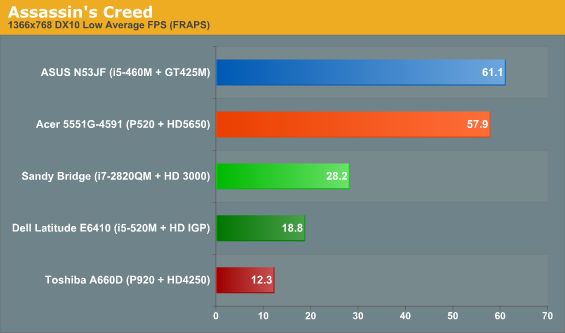

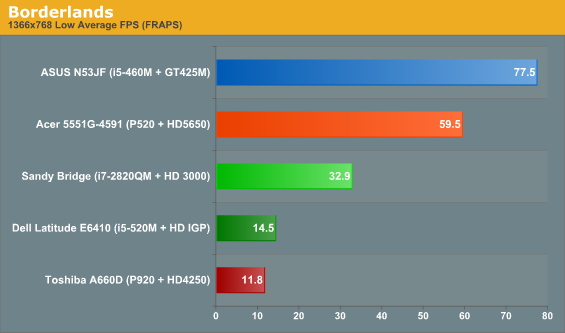
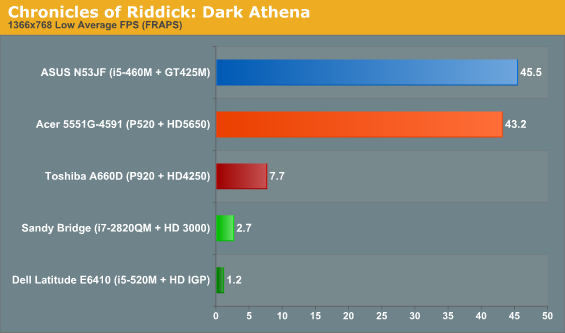

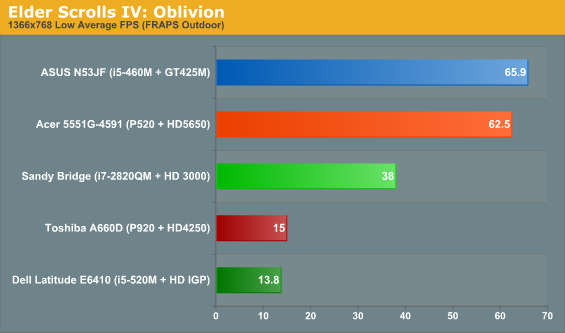
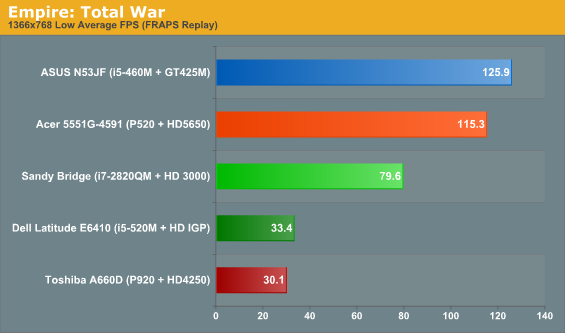
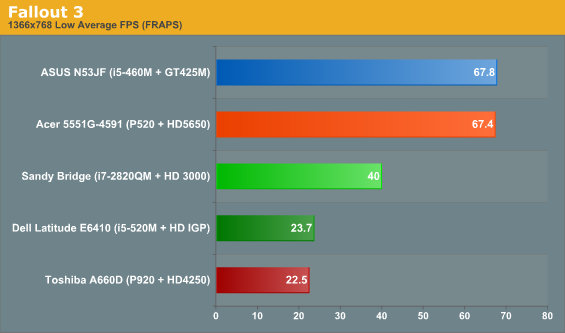
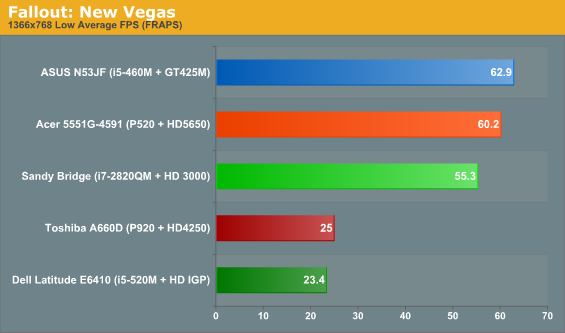
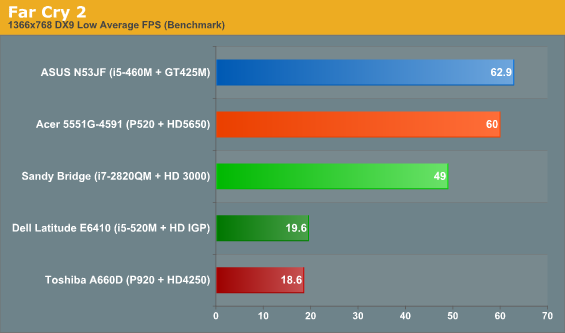
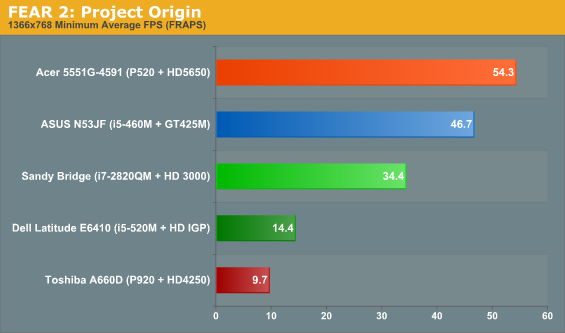

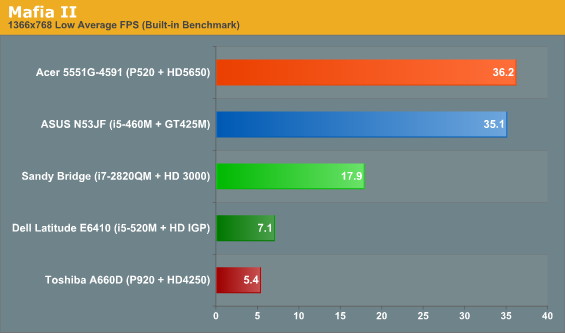
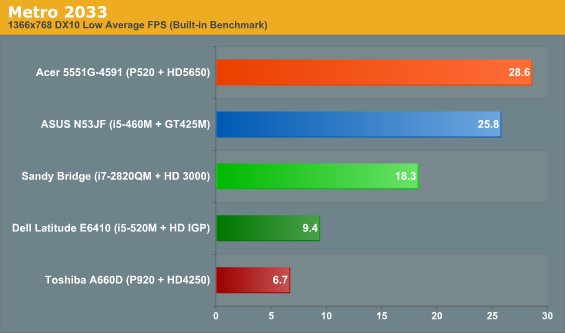
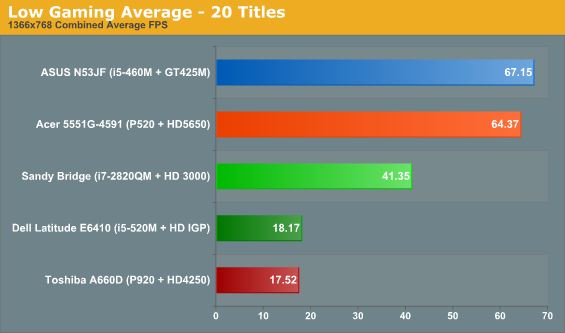
Adding 14 additional titles to the mix exposes a few more areas where Intel’s HD Graphics 3000 chip needs some fine tuning, but again all titles managed to at least run (with a bit of elbow grease). The problem areas run the range of blacklisted titles to minor rendering flaws (sometimes major flaws on older Intel graphics), with one title running but doing so poorly that it may as well have failed the test.
Going into details, first up is the now-infamous Fallout 3, which required a hacked D3D9.dll file to even run (just put the file in the game’s directory—thanks to the creators at OldBlivion). The hacked DLL identifies Intel graphics as a GeForce 7900 GS; without the DLL, the game crashes to the desktop with an error message as soon as you try to enter the actual game world. (Also note that the newer Fallout: New Vegas has no such problems, so Ubisoft was kind enough to stop blacklisting Intel’s IGPs it appears.) There are almost certainly other titles where the Intel IGP is blacklisted, and more than a few games warned of an unknown GPU and potential rendering problems (HAWX 2, Mass Effect 2 and Metro 2033, for instance), but only FO3 required a hack to actually run.
Besides the above, there were some other issues. Assassin’s Creed and HAWX 2 had occasionally flickering polygons, and Mafia II had some rendering issues with shadows; both are minor glitches that don’t render the games unplayable, but in the case of Mafia II performance is too low to be manageable. Finally, the one title from our list that has clear problems with Intel’s current drivers is Chronicles of Riddick: Dark Athena. It’s interesting to note that this is the sole OpenGL title in our suite, and it checks in at a dismal <3FPS. The older Intel HD Graphics on Arrandale has the same issues as HD 3000, with the additional problem of seriously broken rendering in HAWX 2.
Outside of the above problems, performance is typically high enough to handle minimum to medium detail levels. Average frame rates on Sandy Bridge across the 20 test titles ends up at 41FPS. That works out to a 128% improvement over the previous Intel HD Graphics, and a 136% lead over AMD’s HD 4250. The HD 5650 with a slower CPU still leads by over 55%, and GT 425M likewise maintains a comfortable lead of 62%; that said, you can certainly make the case that mainstream gaming is easily achievable with Sandy Bridge. Finally, it’s worth noting that while AMD’s HD 4250 actually ends up slightly slower than the old Intel HD Graphics on average, we didn’t encounter a single noticeable rendering error with that GPU in our test suite.
There are three exceptions to “playability” in our list, counting Dark Athena: both Mafia II and Metro 2033 fail to get above 30FPS, regardless of setting—though Mafia II comes close at 29FPS when set to 800x600. These two titles are a familiar refrain, and it’s worth noting that many discrete mobile GPUs also fail to reach playable performance; in fact, Dark Athena also tends to be a bit too much for anything lower than an HD 5650/GT 420M. They’re the modern equivalent of Crysis, except you can’t even turn down setting enough (without hacking configuration files) to make them run acceptably.










66 Comments
View All Comments
JarredWalton - Tuesday, January 4, 2011 - link
Definitely a driver bug, and I've passed it along to Intel. The HD 4250 manages 7.7FPS, so SNB ought to be able to get at least 15FPS or so. The game is still a beast, though... some would say poorly written, probably, but I just call it "demanding". LOLsemo - Monday, January 3, 2011 - link
Thanks for mentioning USB 3.0 Jarred. It is a much too overlooked essential feature these days. I simply will not pay money for a new laptop in 2011 without a single USB 3.0 port.dmbfeg2 - Monday, January 3, 2011 - link
Which tool do you use to check the turbo frequencies under load?JarredWalton - Monday, January 3, 2011 - link
I had both CPU-Z and the Intel Turbo Monitoring tool up, but neither one supports logging so I have to just eyeball it. The clocks in CPU-Z were generally steady, though it's possible that they would bump up for a few milliseconds and then back down and it simply didn't show up.Shadowmaster625 - Monday, January 3, 2011 - link
On the other Sandy Bridge article by Anand, right on the front page, it is mentioned that the 6EU GT1 (HD2000) die has 504M transistors, while the 12EU GT2 (HD 3000) die has 624M transistors. Yet here you are saying HD Graphics 3000 has 114M. If the 12EU version has 120M more transistors than the 6EU version, then does that not imply a total gpu transistor count well north of 200M?JarredWalton - Monday, January 3, 2011 - link
AFAIK, the 114M figure is for the 12EU core. All of the currently shipping SNB chips are quad-core with the full 12EU on the die, but on certain desktop models Intel disables half the EUs. However, if memory serves there are actually three SNB die coming out. At the top is the full quad-core chip. Whether you have 6EU or 12EU, the die is the same. For the dual-core parts, however, there are two chips. One is a dual-core with 4MB L3 cache and 12EUs, which will also ship in chips where the L3 only shows 3MB. This is the GT1 variant. The other dual-core version is for the ultra-low-cost Pentium brand, which will ship with 6EUs (there will only be 6EU on the die) and no L3 cache, as well as some other missing features (Quick Sync for sure). That's the GT2, and so the missing 120M includes a lot of items.Note: I might not be 100% correct on this, so I'm going to email Anand and our Intel contact for verification.
mino - Monday, January 3, 2011 - link
Nice summary (why was this not in the article ?).Anyway those 114M do not include memory controller, encoding, display output etc. so the comparison with Redwood/Cedar is not really meaningful.
If you actually insist on comparing transistor counts, semething like (Cedar-Redwood)/3 shall give you a reasonable value of AMD's SPU efficiency from transistors/performance POW.
mino - Monday, January 3, 2011 - link
"After all, being able to run a game at all is the first consideration; making it look good is merely the icing on the cake."If making it look good is merely icing on the cake, why bother with GPUs ? Lets just play 2D Mines!
(While for the poor souls stuck with Intel IGPs it certainly is just the icing, for Christ's sake, that is a major _problem_, not a feature !!!)
After a few pages I have decided to forgo the "best-thing-since-sliced-bread" attitude, but, what is too much is too much...
mino - Monday, January 3, 2011 - link
Regardless the attitude, HUGE thanks for listening to comments and including the older games roundup.While I'd love to see more games that actually provide playable frame-rates (read: even older ones) on SNB-class IGPs like Far Cry or HL2, even this mini-roundup is a really big plus.
As for a suggestion on future game-playability roundup on IGP's, it is really simple:
1) Take a look at your 2006-2007 GPU benchmarking suites
2) Add in a few current MMORPGs
JarredWalton - Monday, January 3, 2011 - link
Anand covered several other titles, and most of the pre-2007 stuff should run fine (outside of blacklisting problems or bugs). Time constraints limit how much we can test, obviously, but your "reviewer on crack" comment is appreciated. 2D and 3D are completely different, and while you might feel graphical quality is of paramount importance, the fact of the matter is that SNB graphics are basically at the same level as PS3/Xbox 360 -- something millions of users are "okay" with.NVIDIA and AMD like to show performance at settings where they're barely playable and SNB fails, but that's no better. If "High + 1680x1050" runs at 20FPS with Sandy Bridge vs. 40FPS on discrete mobile GPUs, wouldn't you consider turning down the detail to get performance up? I know I would, and it's the same reason I almost never enable anti-aliasing on laptops: they can't handle it. But if that's what you require, by all means go out and buy more expensive laptops; we certainly don't recommend SNB graphics as the solution for everyone.
Honestly, until AMD gets the Radeon equivalent of Optimus for their GPUs (meaning, AMD GPU + Intel CPU with IGP and automatic switching, plus the ability to update your Radeon and Intel drivers independently), Sandy Bridge + GeForce 400M/500M Optimus is going to be the way to go.